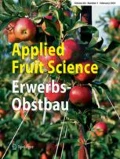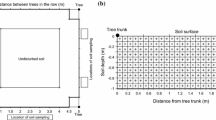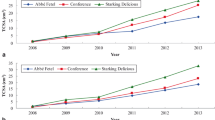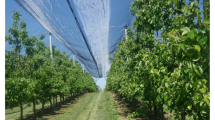Abstract
Plum and apple trees are the most widely spread fruit trees in south-eastern Europe. The main purpose of this paper is to characterize the spatial distribution of roots in medium and course textured soils to improve orchard management. ’Stanley’ plum cultivar grafted on Saint Julien A semi-dwarf rootstock and ’Topaz’ apple cultivar grafted on M.9 dwarf rootstock were studied in a temperate climate and medium and course textured soils. The trench technique was used. There was an intense concentration of roots near the trees and the roots did not occupy the whole soil space between tree rows. The finest tree roots in both species were prevalent. Root density was higher in tree rows versus inter-rows. Both the inter-row and in-row distances can be reduced to increase tree density if light penetration into canopy is sufficient. When a full irrigation regime is applied, a soil depth of 0.8 m would be sufficient for water application, and soil depths of 0.4 to 0.6 m would be recommended for deficit irrigation; water and fertilizers should only be applied over the surface area covering most of the roots. When a more strict control on root activity is desired, the tree roots could be cut vertically at 0.5–0.8 m distance from tree rows. The results could also be used in regions and countries with similar soil texture and climate conditions.
Zusammenfassung
Pflaumen- und Apfelbäume gehören in Süd-Ost-Europa zu den am weitest verbreiteten Obstbäumen. Das Hauptanliegen dieser Arbeit ist es, die räumliche Verteilung von Wurzeln in mittel und grob texturierten Böden zu beschreiben, um die Bewirtschaftung von Obstplantagen zu optimieren. Im gemäßigten Klima auf mittel und grob texturierten Böden wurden die Pflaumensorte ’Stanley‘, veredelt auf der mittelstark wachsenden Unterlage Saint Julian A, und die Apfelsorte ’Topaz‘, veredelt auf der schwachwachsenden Unterlage M9, untersucht. Zur Bestimmung der Durchwurzelungsintensität wurden Profilwände aufgegraben. Die Mehrzahl an Wurzeln wurde nahe am Baum festgestellt und die Wurzeln nahmen nicht den ganzen Bodenraum zwischen den Reihen ein. Vorherrschend bei beiden Arten waren die Feinwurzeln. Die Durchwurzelungsintensität war in den Reihen höher als zwischen den Reihen. Wenn der Lichteinfall auf die Laubwand ausreichend ist, könnten somit die Abstände zwischen und innerhalb der Reihen reduziert werden, um eine größere Pflanzdichte zu erreichen. Bei einer umfassenden Bewässerungsstrategie wird eine Bodentiefe von 0,8 m für die Wasserversorgung als ausreichend angesehen, bei einer Defizitbewässerung wird eine Bodentiefe von 0,4 bis 0,6 m empfohlen. Wasser und Dünger sollten nur auf der Bodenfläche ausgebracht werden, unter der sich die meiste Bewurzelung befindet. Wenn eine bessere Kontrolle der Wurzelaktivität gewünscht ist, kann ein Wurzelschnitt in 0,5–0,8 m Entfernung vom Baumstamm durchgeführt werden. Die Ergebnisse können ebenso auf Regionen und Länder mit vergleichbaren Bodenstrukturen und Klimabedingungen übertragen werden.




Similar content being viewed by others
References
Asaah EK, Tchoundjeu Z, Wanduku TN, van Damme P (2010) Understanding structural roots system of 5‑year-old African plum tree (D. edulis)of seed and vegetative origins (G. Don) H. J. Lam. Trees 24(5):789–796
Atkinson D (1980) The distribution and effectiveness of the roots of tree crops. Hortic Rev (Am Soc Hortic Sci) 2:424–490
Aïvazian S (1970) Étude statistique des dépendances. Edition Mir, Moscou, p 236
Basile B, Bryla DR, Salsman ML, Marsal J, Cirillo C, Johnson RS, DeJong TM (2007) Growth patterns and morphology of fine roots of size-controlling and invigorating peach rootstocks. Tree Physiol 27:231–241
Black BL, Drost D, Lindstrom T, Reeve J, Gunnell JD, Reighard GL (2010) A comparison of root distribution patterns among prunus rootstocks. J Am Pomol Soc 64(1):52–62
Böhm W (1979) Methods of studying root systems. Springer, Berlin, p 188
Comas LH, Bouma TJ, Eissenstat DM (2002) Linking root traits to potential growth rate in six temperate tree species. Oecologia 132:34–43
Dragavtsev AP (1936) The root system of subtropical fruit plants growing in northern areas (in Russian). Trudy sochinskoy op. stantsii subtr. i yuzhn. Plodovykh Kult 10
Fernandez RT, Perry RL, Flore JA (1992) Physiological responses of young apple trees on three rootstocks to drought stress. HortScience 27:85
Fernandez RT, Perry RL, Ferree DC (1995) Root distribution patterns of nine apple rootstocks in two contrasting soil types. J Am Soc Hortic Sci 120(1):6–13
Florea N, Munteanu I (2012) Romanian soil taxonomy system–SRTS. Editura Sitech, Craiova, p 206
Florea N, Balaceanu V, Rauta C, Canarache A (1987) Methodology of elaboration of soil science studies. Partea I, II III. redactia de propaganda tehnica agricola. ICPA, Bucuresti
Glenn DM, Welker WV (1993) Root development patterns in field grown peachtrees. J Am Soc Hortic Sci 118(3):362–365
Levin IR, Bravdo AB (1979) Soil moisture and root distribution in an apple orchard irrigated by tricklers. Plant Soil 52:31–40
Liang Y, Gao SR, Bo CP, Yang Y, Wang SW, Pan CD, Chen GA (2011) Spatial distribution characteristics of absorbing roots of apricot trees in the intercropping systems. Xinjiang Agric Sci 48(5):821–825
Oskamp J, Batjer LP (1932) Soils in relation to fruit growing in New York. II. Size, production and rooting habit of apple trees on different soil types in the helton and morton areas, Monroe County. Cornell University, Agricultural Experiment Station, Ithaca, p 550
Paltineanu C, Septar L, Gavat C, Chitu E, Iancu M, Oprita A, Moale C, Lamureanu G, Calciu I, Stroe VM (2015) Spatial distribution of apricot roots in a semi-arid environment. Agrofor Syst. doi:10.1007/s10457-015-9869-8
Paltineanu C, Septar L, Gavat C, Chitu E, Oprita A, Moale C, Calciu I, Vizitiu O, Lamureanu G (2016) Characterizing root density of peach trees in a semi-arid chernozem to increase plant density. Int Agrophys 30(1):67–74. doi:10.1515/intag-2015-0079
Parker ML, Meyer JR (1996) Peach tree vegetative and root growth respond to orchard floor management. HortScience 31(3):330–333
Perry RL (1984) Working with soil limitations for orchard crops. Ontario Horticultural Conference, 1984. Ministry of Agriculture and Food, Ontario, pp 164–171 (Proceedings)
Psarras G, Merwin IA, Lakso AN, Ray JA (2000) Root growth phenology, root longevity, and rhizosphere respiration of field grown ’Mutsu’ apple trees on ’Malling 9’ rootstock. J Am Soc Hortic Sci 125:596–602
Ruiz-Sánchez MC, Plana V, Ortuño MF, Tapia LM, Abrisqueta JM (2005) Spatial root distribution of apricot trees in different soil tillage practices. Plant Soil 272(1):211–221
Tanasescu N, Paltineanu C (2004) Root distribution of apple tree (‘Golden Delicious’) under various irrigation systems within in the hilly region of Romania. Int Agrophysics 18(2):175–180
Vercambre G, Pagès L, Doussan C, Habib R (2003) Architectural analysis and synthesis of the plum tree root system in an orchard using a quantitative modelling approach. Plant Soil 251(1):1–11
Williamson JG, Coston DC, Cornell JA (1992) Root restriction affects shoot development of peach in a high-density orchard. J Am Soc Hortic Sci 117(3):362–367
Yıldırım F, Yıldırım AN, San B, Ercişli S (2016a) The relationship between growth vigour of rootstock and phenolic contents in apple (malus × domestica). Erwerbs Obstbau 58(1):25–29. doi:1007/s10341-015-0253-7
Yıldırım F, Vural E, Uçar Y, Yıldırım AN (2016b) Interaction of Crop Load and Irrigation on Yield, Fruit Size, Color and Stem-end Splitting Ratio of Apple c.v. ‘Gala, Galaxy. Erwerbs-Obstbau 58(2):103–111
Acknowledgements
The authors are grateful for the financial support received from the Romanian Ministry of Agriculture and Rural Development: the project ADER 3.3.12 – The increase in the technical-economic competitiveness in fruit growing by using technologies adapted to the soil and climate conditions of Romania aiming at implementing the fruit growing Subprogram in years 2015–2020.
Author information
Authors and Affiliations
Corresponding author
Rights and permissions
About this article
Cite this article
Paltineanu, C., Nicolae, S., Tanasescu, N. et al. Investigating Root Density of Plum and Apple Trees Grafted on Low-Vigor Rootstocks to Improve Orchard Management. Erwerbs-Obstbau 59, 29–37 (2017). https://doi.org/10.1007/s10341-016-0293-7
Received:
Accepted:
Published:
Issue Date:
DOI: https://doi.org/10.1007/s10341-016-0293-7




